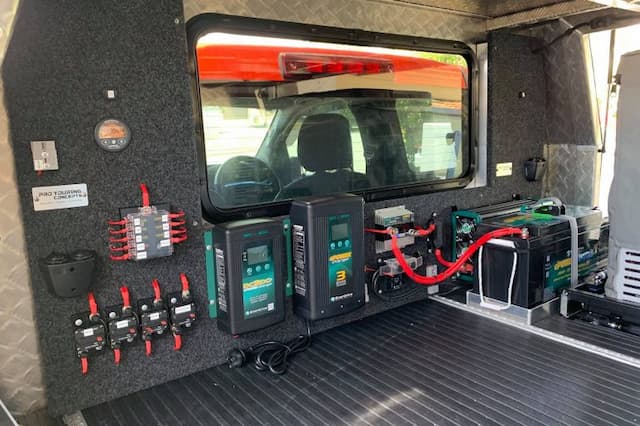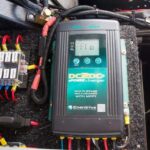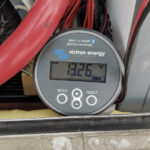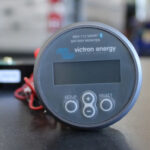If you’re really into camping or off-roading, your car battery won’t be enough to provide the juice to run all the devices and appliances that bring that extra dose of comfort and convenience. This is the task of an auxiliary battery, that differs from the starter battery under the bonnet in a few significant ways. First is the way the battery charges, providing sustained voltage over a longer period. And the fact that they can be recharged and discharged (or deep-cycled) without causing any damage or shortening their life. This is owed to the thicker plates inside, as compared to lead-acid starter batteries, and up efficiency in use.
To charge a deep-cycle battery you’ll need a DC-DC charger. This is a necessary component in any solar-based battery system that most campers and off-roaders use for their power needs.
What are DC-DC Chargers?

DC-DC chargers are in essence battery-to-battery chargers. They charge an auxiliary deep-cycle battery using the power from your vehicle’s alternator, with the engine running. Some variants, like a DC-DC charger with solar input, can simultaneously harness the power of your solar panel installation and that of the alternator. These allow faster and more efficient charging while reducing the stress and pull from the alternator, and risking depleting the charge in your car battery. Charging can continue with the engine turned off, and you won’t need additional external or inline solar regulators to get your battery charged. These are built into the charger.
How do DC-DC Chargers Work?
A DC-DC charger ensures that your auxiliary deep-cycle battery gets the right amount of charge in a safe, fast, and regulated way. The majority of vehicles today have smart alternators that limit the voltage they can provide. This is all in the name of reduced emissions and efficiency. At best, charging a secondary battery from a smart alternator will prove tedious, if not downright impossible. Optimised to charge the car battery and vehicle electrical systems, these alternators just don’t have enough output to charge a secondary battery the traditional way (using an isolator). This is where a DC-DC charge steps in. It has the electronic smarts to overcome this and charge your battery in an efficient way.
A DC to DC charger takes whatever output is available from the alternator and converts this to a higher rate of amperage. It will charge the secondary battery at the current it can take. The rating of the charger determines the charging speed. A DC-Dc charge with high amperage then will charge your battery faster. And they do this safely and in stages. The first ‘boost’ stage delivers a maximum voltage to a near-depleted battery. This then lowers in the ‘absorption’ stage to a continual charge until the battery current demand drops to 4 amps. Last is the ‘float’ stage which keeps the battery fully charged and with a voltage of 13.3 V.
A DC-DC charger with solar input goes one step further in that it does away with separate and costly solar controllers, and also allows to charge of the secondary battery whilst on the move. Here it spares the alternator from working too hard and automatically prioritises solar charging to reduce fuel consumption.
Benefits of DC-DC Chargers
DC to DC chargers are the best way to keep your 12V battery system fully charged at all times. They can be used both while driving or with the vehicle parked. Here a combination charger with solar input works best. It can take the voltage from panels, and when on the move, from any type of alternator. Fitted to vehicles like motorhomes and vans, with panels fixed on the roof, this is often done at the same time.
Optimal charging is assured in cars with computer-controlled alternators. The benefits of isolators and older vehicles are also evident. These can only reach 80 per cent charge in secondary batteries and at a fixed charge rate. The multi-stage charging in a DC-DC charger, however, means that batteries will always be topped up. If you have a battery bank with several secondary batteries, then this means less time and more efficiency. You’ll have the needed power to run any appliance or device whenever you need it.
Another thing to consider is that most DC-DC chargers have charge profiles for different kinds of deep-cycle batteries. They will automatically adjust charging levels, depending on whether you have a lead acid, AGM, Calcium, or Lithium battery. This ensures that batteries maintain optimal life cycles and last longer as a result.
Which DC-DC Charger Should I Get?

If you’re considering a DC-DC charger as an integral part of a dual battery system, size, amps and solar compatibility are the main factors. This means calculating your overall energy needs. A rule of thumb is that you need a charger with an Amp output of 10-20% of the battery capacity. For example, a 100Ah AGM Battery will benefit from a 20Amp DC-DC charger. For Lithium batteries, the charging output should be at least 30% of the battery capacity or around 40 amps.
DC-DC chargers with solar input offer more usability, at a slightly higher price that is certainly worth it. You won’t be shelling out extra cash for a separate solar regulator, so as not to cook the battery from too much charge.
Lastly, most brands offer high-quality chargers that are heat, dust, and water resistant, meaning they can be placed under the hood (in a dedicated tray) without fear of damage. Being closer to the starter battery and alternator definitely helps with charging efficiency. If space is a limiting factor here, then brackets and mounting trays allow you to install the battery wherever you deem fit.






















